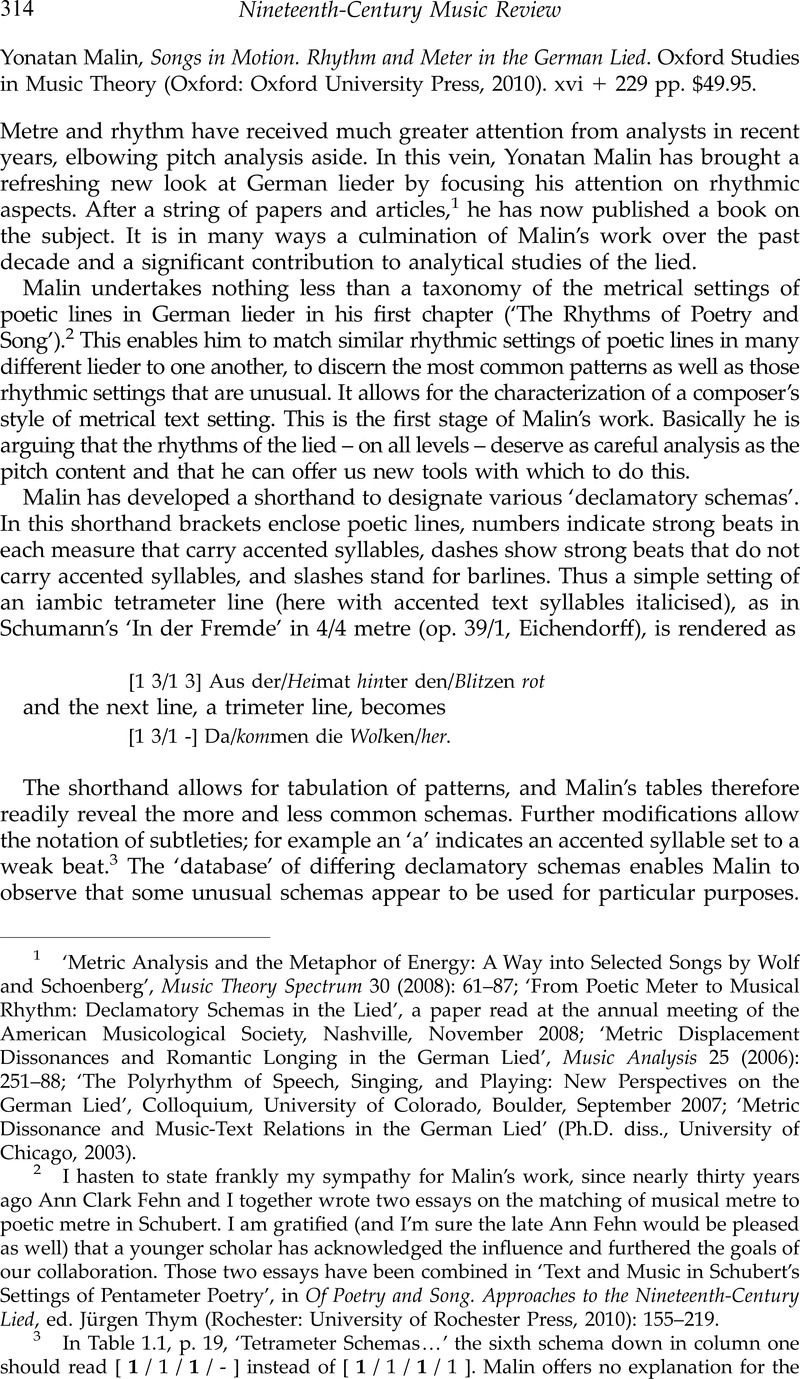No CrossRef data available.
Article contents
Yonatan Malin, Songs in Motion. Rhythm and Meter in the German Lied. Oxford Studies in Music Theory (Oxford: Oxford University Press, 2010). xvi + 229 pp. $49.95.
Review products
Published online by Cambridge University Press: 24 November 2011
Abstract

- Type
- Book Reviews
- Information
- Nineteenth-Century Music Review , Volume 8 , Issue 2: Mahler: Centenary Commentaries on Musical Meaning , 24 November 2011 , pp. 314 - 320
- Copyright
- Copyright © Cambridge University Press 2011
References
1 ‘Metric Analysis and the Metaphor of Energy: A Way into Selected Songs by Wolf and Schoenberg’, Music Theory Spectrum 30 (2008): 61–87; ‘From Poetic Meter to Musical Rhythm: Declamatory Schemas in the Lied’, a paper read at the annual meeting of the American Musicological Society, Nashville, November 2008; ‘Metric Displacement Dissonances and Romantic Longing in the German Lied’, Music Analysis 25 (2006): 251–88; ‘The Polyrhythm of Speech, Singing, and Playing: New Perspectives on the German Lied’, Colloquium, University of Colorado, Boulder, September 2007; ‘Metric Dissonance and Music-Text Relations in the German Lied’ (Ph.D. diss., University of Chicago, 2003).
2 I hasten to state frankly my sympathy for Malin's work, since nearly thirty years ago Ann Clark Fehn and I together wrote two essays on the matching of musical metre to poetic metre in Schubert. I am gratified (and I'm sure the late Ann Fehn would be pleased as well) that a younger scholar has acknowledged the influence and furthered the goals of our collaboration. Those two essays have been combined in ‘Text and Music in Schubert's Settings of Pentameter Poetry’, in Of Poetry and Song. Approaches to the Nineteenth-Century Lied, ed. Jürgen Thym (Rochester: University of Rochester Press, 2010): 155–219.
3 In Table 1.1, p. 19, ‘Tetrameter Schemas…’ the sixth schema down in column one should read [ 1 / 1 / 1 / - ] instead of [ 1 / 1 / 1 / 1 ]. Malin offers no explanation for the boldface type, though it appears to indicate the ‘downbeat’ corresponding to the 1s in the more typical tetrameter schema in 4/4 [ 1, 2 / 1, 2 ], of which Schumann's cut-time notation is a compound version.
4 Cone, Edward T., The Composer's Voice (Berkeley: University of California Press, 1974)Google Scholar.
5 Hoeckner, Berthold, ‘Poet's Love and Composer's Love’, Music Theory Online 7/5 (2001), http://mto.societymusictheory.org/issues/mto.01.7.5/mto.01.7.5.hoeckner.html.Google Scholar
6 These studies are too numerous to list here, but they are all individually cited in Malin's footnotes in Chapter 2 and included in his bibliography.
7 Some misprints on p. 62 mar Malin's presentation of Richard Cohn's graphic representations of hemiola. First, in line 9 of the second paragraph, the ‘w.’ should be a dotted whole note, and in Ex. 2.16, the topmost note value should also be a dotted whole note. Here are a few other errors in the text: p. 39, para. 4, line 6, ‘ninth’ should be ‘tenth’; p. 99, the symbol for scale degree five – the numeral five with a caret above it – is misaligned, the caret preceding the numeral; p. 115, ‘W/o’ for ‘Wo’ in stanza 2 of ‘Gretchen am Spinnrade’.
8 In this chapter Malin begins to rely more heavily on a helpful feature of his book that is now becoming a not uncommon resource for authors (and publishers) – reference to extended musical examples online (in this case at his Oxford University Press website), which can be viewed there or printed out.
9 This clever finagling by Schubert is something to which I called attention in a lecture many years ago, which has recently been published. See ‘On Schubert Reading Poetry. A Primer in the Rhythm of Poetry and Music’, in Of Poetry and Song. Approaches to the Nineteenth-Century Lied, ed. Jürgen Thym (Rochester: University of Rochester Press, 2010): 3–36. ‘Schäfers Klagelied’ is discussed on pp. 14–15.
10 In the ninth line of the first whole paragraph, the text should refer to stanzas (not lines) 9 and 10.
11 Cited in footnotes 6 and 7 on p. 124.
12 See for example Komar, Arthur, Schumann. Dichterliebe (New York: Norton, 1971): 85Google Scholar.
13 Agawu, Kofi, ‘Theory and Practice in the Analysis of the Nineteenth-Century Lied’, Music Analysis 11 (1992): 3–36CrossRefGoogle Scholar.
14 Ciardi, John, How Does a Poem Mean? Vol. 3 of An Introduction to Literature, ed. Gordon N. Ray (Boston: Houghton Mifflin, 1959)Google Scholar.


